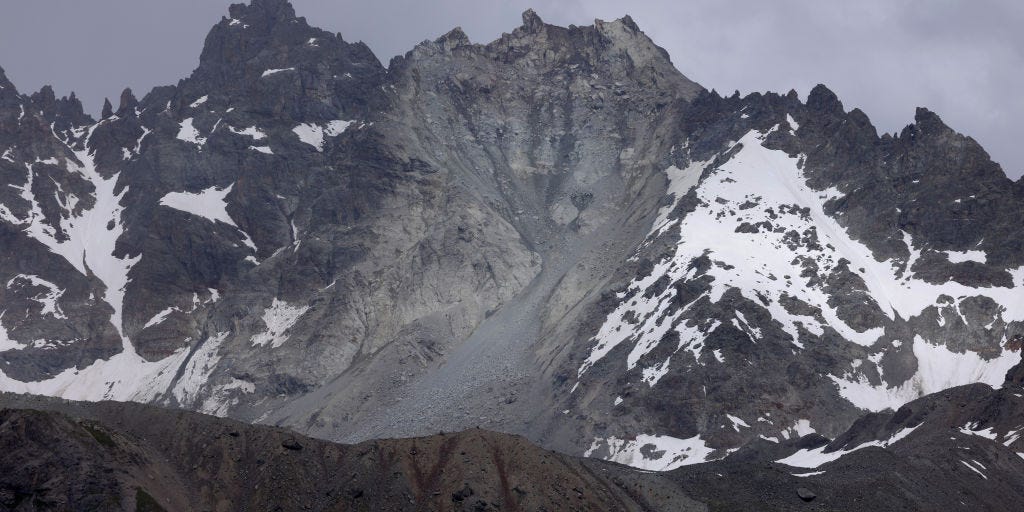Mt. Fluchthorn’s tallest peak, on the Swiss-Austrian border, collapsed in June.
Experts say peaks in the European Alps and Southern Alps of New Zealand are at risk of collapse, too.
The damage and dangers from mountain collapse disproportionately impact indigenous communities.
On June 11, the main peak of Mt. Fluchthorn, on the border of Austria and Switzerland, collapsed without warning.
Roughly 3.5 million cubic feet of earth tumbled down, filling the valley below with 40 Olympic swimming pools’ worth of rocks, mud, and dirt, LiveScience reported. While no people got hurt, a religious cross marking the summit was destroyed.
Fluchthorn had three peaks, and the main, southern one used to be the tallest. With the south peak collapsed, the middle peak is the new summit at 11,145 feet — the second-highest summit in the Silvretta Alps.
Overall, Mt. Fluchthorn is 60 feet shorter than it was earlier this year, per LiveScience.
Why did the peak collapse? Well, like many mountains in the far north, Fluchthorn had a lot of permafrost — a permanent layer of ice and dirt under the mountain’s surface.
“Permafrost is important because frozen water within the ground holds the ground surface together and prevents it from moving. But when that ice melts, the liquid water can flow away. The ground surface becomes less stable and can move, often very quickly,” said Jasper Knight, a geoscientist at the University of Witwatersrand in South Africa.
When a big chunk of mountain moves quickly, like with the mudslide at Fluchthorn, that’s called a mass movement.
“Global warming is causing the permafrost to melt, which is the trigger for these mass movement events to take place,” Knight said.
Kind of interesting but movement of Earth equivalent to 40 Olympic swimming pools is rather miniscule when you compare that to a mountain peak much less a mountain.
The only certain things in life are death and mountains eroding slowly over millennia
It seems like that’s just what ended up in the valley. 40 Olympic swimming pools is only 100,000 m3, but the title says 3,5 million m3 fell in the rockslide.
3.5 million cubic feet not meters.
There are about 10 cubic feet in a m^3.
So about 1/3 of the rock fall made it all the way into the valley.
Woops, thanks for the correction.
Yeah, this seems like a stretch to connect a relatively minor rockslide to CLIMATE CHANGE! and INDIGENOUS COMMUNITIES! Those hotbutton words get the clicks, though.
“Global warming is causing the permafrost to melt, which is the trigger for these mass movement events to take place,” Knight said.
Across the world, mountains with permafrost melt have shown larger and more frequent landslides, the Intergovernmental Panel on Climate Change reported. Research on rockfalls in the Alps suggests summer heat waves are a common trigger for melting permafrost.
But warming temperatures due to climate change affect more than permafrost. The surface layer of ice and snow can melt, too, and cause flooding and mudslides. Melting glaciers can also cause mass movements, when mountains lose the ice that was propping up its sides for years on end, per the IPCC.
That doesn’t seem like a stretch at all.
The headline says “mountains are collapsing.” Mountains are not made of permafrost. Some of them have some permafrost in the soil on them, which is what sloughed off in this particular case, but calling that “mountains collapsing” is ridiculous.
And really, glaciers prop up mountains?
There are real, serious implications to climate change. Mountains collapsing is not one of them. And how they leap from there to “indigenous communities are disproportionately affected” is even weirder, why do indigenous people prefer to live on mountains? Who are the “indigenous people” in Switzerland anyway?
But how do you explain all the known rock slides far before global warming became an issue? Some far larger.
But the situation isn’t hopeless. Scientists believe if we work now to slow down climate change and prevent mountain degradation, we can still stop the worst outcomes from happening and help protect the planet’s mountains and the communities that live near them.
I hate it so much when articles end like this. 1) It’s something the journalist wants to believe, scientist would not start a sentence with “but I belive…” 2) yea but we don’t do anything like that, what we do is not enough and not fast enough, so no: the situation IS hopeless 😖
But when it is hopeless there is also no more incentive to do anything.
deleted by creator
Style guides often tell journalists to avoid saying what someone “believes”, as you can’t know what’s inside someone else’s mind. We can only know what they say.
Scientists say if we work now to slow down climate change and prevent mountain degradation, we can still stop the worst outcomes…
ApparentlyProbably ChatGPT often ignores what style guides often tell journalists, it’s just a bad article 😒
deleted by creator
Swiss mountain collapse. New Zealand has mountains that might collapse.
And it’s primarily a danger to the indigenous people in South America.
Explained by a scientist from Africa.
Finally some actual world news.
Welp, that wasn’t on my Apocalypse Bingo card.
This is the best summary I could come up with:
Roughly 3.5 million cubic feet of earth tumbled down, filling the valley below with 40 Olympic swimming pools’ worth of rocks, mud, and dirt, LiveScience reported.
Across the world, mountains with permafrost melt have shown larger and more frequent landslides, the Intergovernmental Panel on Climate Change reported.
Mass movements can also increase the risk of blocked roads, damaged farmland, and mercury contamination in local bodies of water.
Argumedo and Stenner said Andean indigenous peoples have an in-depth system of traditional knowledge to predict and cope with extreme weather conditions on the mountainside.
One strategy they use are agricultural terraces — step-like tiers of farmland set along the mountain’s slope — that “prevent soil erosion and landslides,” Argumedo said.
He added that for the terrace strategy to work, the top of the mountain needs natural pasture and native tree species to act as sponges for extra water.
I’m a bot and I’m open source!
How many m^3 are in a fucking Olympic swimming pool?
2,500-ish. Regulations only give a minimum pool depth (2m).
So there was about 100,000m^3 in the rock fall.
Thanks for the clarification but I wish they would report actual numbers.
They said 3.5 million cubic feet in the article, which you may not consider an actual number (cuz the imperial system is shit) but it’s convertible into cubic meters, which comes out to 99108.963m^3 so you were pretty close.
deleted by creator
Am not a farmer but, doesn’t terrace farming lead to soil erosion and lead to more mudslides? Typically because most trees are removed along the mountain sides which would have larger root networks than crops?
A similar issue is going on in china with promotion of terrace farming and crop loss in recent floods.
At this height there are no trees in the alps. There is mostly rock and ice. And when the ice melts the rocks loose their connection or the melting extending ice/water let them crack.
The terrace farming was suggested as solution in south america not the alps. I doubt there is much scope for any farming on the Alps or any similar terrain.
And how exactly would permafrost work in a mostly rocky terrain, unless its very loose small gravely soil. Most tall peaks at those elevations are large contiguous rocks. Its hard to believe those were held together by permafrost. I might be missing some context here.
Not above the tree line, no, most of it is either forestry (carefully) and/or cow pastures though there’s also some crazies up there doing permaculture and growing kiwifruit. I’m not kidding you can do a lot of shit with wind shielding and generally furnishing the terrain to work for you, it’s not that the area lacks sunshine. That’s kind of the problem in a sense isn’t it.
In any case none of that would help stabilising thawing permafrost above the treeline. Pretty much the only thing that can be done short of driving pillars into the ground all over the place is making sure there’s snow cover, if need be artificial, to reflect sunlight.
Those gravelly permafrost areas are either what’s left of glaciers, or otherwise the result of erosion, nothing ever really grew there but lichen and the occasional ridiculously hardy plant, but nothing with any amount of noticeable root system – hence the term “above the tree line”.
They’re very good at managing that kind of stuff in the Alps, the general principle being to let stuff come down (also snowslides etc) but make sure that it’s coming down in a place and at a time where noone gets hurt. You don’t want to fight gravity, not on that scale. They have every corner of those montains mapped and have ages of experience in how things behave.
Like the Rhaetian Railway easily could be the most dangerous railway track in the world due to the absolutely insane terrain it crosses but, well, it’s in Switzerland.
As to the indigenous people: They’re Swiss. Davos can afford to relocate itself.
Mountains collapsing wasn’t on my 2023 bingo card, but somehow it feels appropriate
I don’t know about you guys, but this reality is starting to feel more and more like the things that we used to see in movies. The kind of things that were so bizarre that we scoffed at. I don’t like where this is all heading, especially considering it’s happening much faster than initially predicted. It just keeps gaining momentum.
I know we’re not doomed yet, but most people don’t seem to give a hoot. Others see snow and denounce that any of this has anything to do with global warming. It’s a bit depressing sometimes, tbh.
It makes sense to me now, but I never thought that I would see a headline like this.
Good, for too long gods have been living up on these mountains rent free while working class people have to live in the valleys.
No deaths but a graven image destroyed, hmm…
Permafrost was holding a mountain together? I mean, I’ll defer to the “geoscientist” but that’s surprising.
deleted by creator
Do you usually call yourself a “geoscientist” or something more specific? I don’t recall hearing that name before.
deleted by creator
Would geologist not cover that?
deleted by creator
Fair enough, thanks for the replies. Not sure why “geoscientist” sounded so foreign to me when I first read it.
Nah I don’t really buy this one, landslides like this are normal. Anyone heard of Frank Slide?
https://en.wikipedia.org/wiki/Frank_Slide?wprov=sfla1
There are tectonic plates colliding beneath mountains and they are unstable lol











